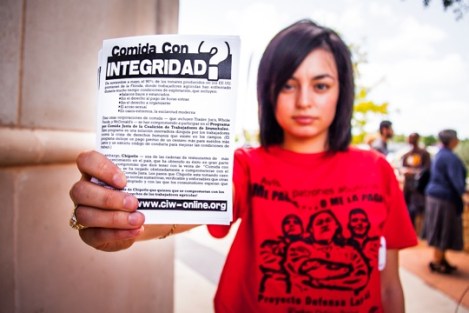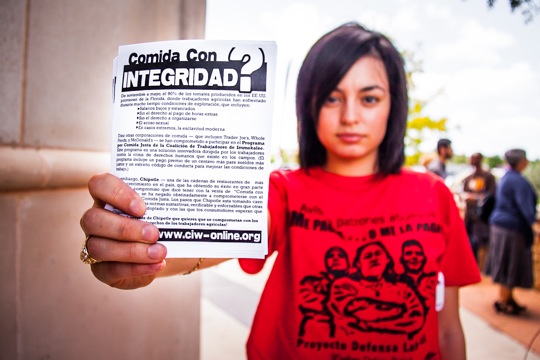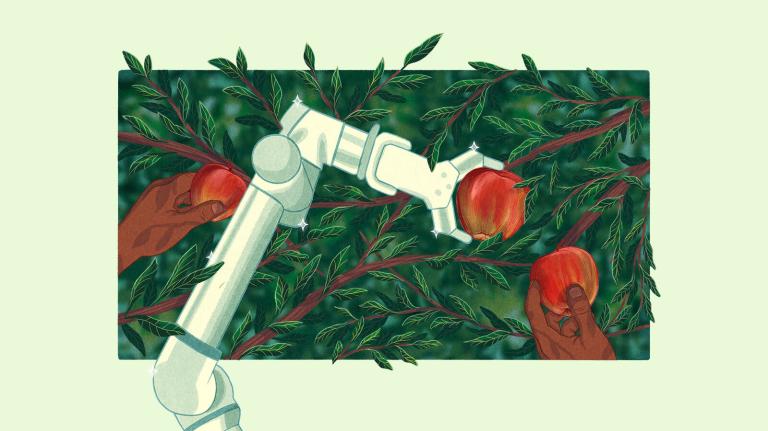
Activists participate in a National Day of Action urging Chipotle to sign a Fair Food Agreement with Florida tomato workers. (Photo by Hai Vo.)
U.K. resident and activist Bethan Tichborne wants to see the fast food giant Chipotle sign an agreement to treat farmworkers fairly, so she organized to create an international component of a U.S.-based Day of Action to get Chipotle’s attention earlier this week.
“We found out on Monday that Chipotle has plans to expand in the U.K.,” says Tichborne. “So we’re pretty pleased that by Wednesday we had a people from all around the country handing out several hundred leaflets at one of the three already existing branches in London! … We had a great response from passers-by and most of the customers that we spoke to. Some said they would think twice before eating there again.”
Tichborne was joined by several hundred students, activists, and other conscious consumers, who gathered in 25 American cities in support of a group of Florida tomato workers organizing for improved wages and labor conditions. The target was Chipotle, the fast food chain known for a comparatively progressive approach to sourcing its food (the company uses meat raised without antibiotics, and sources at least some of its produce from local and organic sources). Activists — led by the Coalition of Immokalee Workers (CIW) and the nonprofit group Just Harvest — are demanding that Chipotle join 10 other fast food restaurants, food service companies, and grocery stores, including McDonald’s, Taco Bell, Burger King, Subway, Trader Joe’s, and Whole Foods, in signing onto the CIW Fair Food Program.

A young activist hands out a flyer outside Chipotle on the recent Day of Action against the chain.
The inhumane conditions faced by Florida farmworkers are well documented. Not only do they work long hours in sweltering heat, but they’re paid by the pound, earn less than $12,000 a year on average, and they’re often directly exposed to pesticides. (In Tomatoland, Barry Estabrook’s 2011 chronicle of the Immokaleee workers’ plight, he describes encountering numerous workers who come home from the fields with their clothes soaked through with liquid pesticides). After nearly two decades of organizing, CIW has seen improvements and their Fair Food Program is making a dent in the atrocities. But there’s clearly a long way to go.
Different frames, shared goals
The larger question — and one I hear asked a lot these days — is where and how do worker issues fit into the so-called Good Food Movement?
Indeed, worker justice can often seem like the phantom limb of this relatively new movement. Sure, it’s common to rattle off words like “fair” and “just” on the list of what makes food sustainable, but how often do you really hear about actual labor organizing in the context of food?
That’s why I was interested to hear of a report called “Good Food, Good Jobs for All,” published earlier this month by the Applied Research Center (ARC). As the name implies, the report speaks to this schism and makes recommendations for ways to close the gap between what are often two very different groups of people — those agitating for sustainable, organic, and local food and those working for fair wages and other worker’s issues.
In many ways, this report couldn’t come at a better time. Rinku Sen, director of ARC, described the motivation on Colorlines, the organization’s news and analysis site, like so:
What could happen, we wondered, if the people who work to ensure good eating and those who fight for labor rights were to strategize together and move projects that addressed both issues simultaneously?
The report follows another released by ARC last year called “The Color of Food” [PDF], which found that people of color and women are concentrated in low-wage jobs in the food chain, where they earn less than their white counterparts and are much less likely to hold management positions. Although farmworkers, like those in Florida, face some of the worst conditions and are therefore often held up as examples, there’s an increased push from groups like the Food Chain Workers Alliance to recognize a whole range of underpaid, under-recognized folks along the food chain — from meat packers, to factory workers, to dishwashers.
Meanwhile, the food movement is maturing to the point where what started for many as a quest for healthy, delicious local produce has developed into an increasingly nuanced critique of our industrialized, heavily subsidized system at large (New York Times columnist Mark Bittman’s evolution from recipes to scathing analysis of food policy is probably the best example of this shift). So it just might be possible that there’s an opening for class and race issues — arguably the core of the labor issue — to enter the food discussion in a legitimate way.
“We are trying to capitalize on the fact that there is a growing interest in food procurement and production and hoping to bring that over to get people to care about labor conditions,” says Yvonne Liu, the author of the “Good Food, Good Jobs for All” study. Liu interviewed more than 30 leaders in the good food and good jobs movements and compiled responses to a survey by around 180 respondents. In the end, she found that both sides were wary of working together.
On the one hand, Liu found, those in the food movement worried that including labor in their messaging would water it down, or, as one anonymous interviewee said, cause them to “lose our specificity and attraction for people who can deal with food, but not economic systems.” On the other hand, labor organizers weren’t always clued in to how to truly harness the food movement. “I’m not sure if labor is engaged, beyond saying that food workers have horrible working conditions, to embrace a systemic critique of the food system,” an anonymous good jobs advocate told Liu.
“The way [food advocates] enter into being politicized around food is through their personal consumption choices and lifestyle decisions,” says Liu. In other words, expecting everyone to embrace a broader analysis that also takes into account social and economic systems as they relate to food might be a lot to ask.
“A lot of the folks I talked to who were working in the food movement responded by saying that issues like labor, poverty, unemployment, weren’t applicable to the work that they do. They didn’t see the ability to choose what food you eat as embedded in questions like are there jobs available, is there a living wage, etc.”
And yet, she admits, labor activists haven’t traditionally been the most inclusive either.
“The labor movement doesn’t often reach out to the larger progressive movement. And yet for trade unions to continue to stay viable in this economy, there needs to be an acknowledgement on their part that there is a real need to localize economies. We have shifted from an industrial economy to a more service-based one. It serves their interest to support sustainable agriculture, local economies, and regional food systems.”
Can’t we all just get along?
What’s the best way to integrate these two populations? As Liu sees it, the most obvious answer is to invite more workers to participate in discussions about food and more people of color into leadership roles in the food movement. Doing so would mirror the developments of the environmental justice movement, which began in earnest in 1991 after a group of people of color met to define environmental justice for themselves at the now-famous First National People of Color Environmental Leadership Summit.
“At the time, they asked, ‘What does the movement to protect the rights of Mother Earth look like when we put justice at the center of it? What does it look like when we privilege the leadership of those most impacted by environmental toxins and resource extraction?’” says Liu. Now, as she sees it, “something similar needs to happen for the food movement.”



